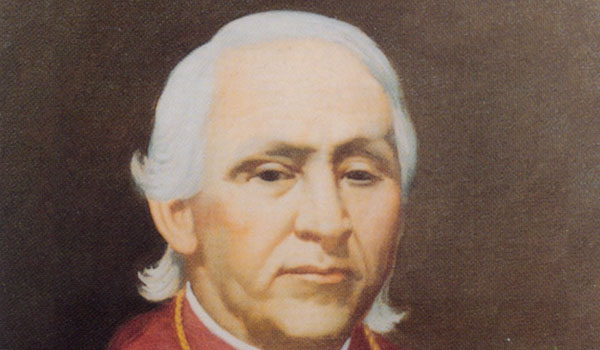Bishop John Timon, the father of our diocese
by PAUL LUBIENECKI
Editor's Note: Dr. Dennis Castillo will speak about Bishop Timon in his "Lion of God" lecture at Christ the King Seminary June 21. Check the link for more info.
Father John Timon, a Vincentian priest, arrived in Buffalo in June 1847 to establish a new Catholic diocese in Western New York. He would serve as the first bishop of the diocese, ushering in religious orders, developing health care, and creating a Catholic identity for the city that would remain 170 years later.
Timon was born in Conewago, Pa., on Feb. 12, 1797 of Irish immigrant parents from County Cavan. He often stated that he was conceived in Ireland but born in America. When he was 3 years old, the family moved to Baltimore, where his father, James, achieved some success and prosperity as a merchant. In 1811, the young man was enrolled at St. Mary's College in Baltimore as a day student. Upon graduation, he entered the family business. Due to an economic recession and a failing business, the Timons moved to Louisville, Ky., in 1818, where they opened a short-lived general merchandise store. The following year, they relocated to St. Louis.
In July 1822, Timon entered St. Mary of the Barrens Seminary, near St. Louis, as a diocesan candidate. His path of study and discernment however, led him a year later to transfer his candidacy to the Congregation of the Mission. He was ordained a priest in September 1826 and was immediately immersed into the realities of ministry. In addition to teaching duties at the seminary and college where he taught English and the natural sciences, he served as treasurer, parish priest, spiritual director for the neighboring Lorettine sisters, and occasional missionary in southwest Illinois and Missouri. So effective were Father Timon's pastoral activities that Bishop Joseph Rosati, CM, after some years of observing him, said without exaggeration that John Timon made more converts to the Church, and brought back more lapsed Catholics to the faith, than did all the other priests combined laboring in the diocese of St. Louis.
In 1835, Father Timon's administrative skills were rewarded with his appointment as the first superior of the Vincentian community in America. He was selected as the first prefect apostolic (the highest-ranking Catholic cleric) to the new Republic of Texas in 1849. During his tenure, Father Timon reinvigorated the faith there, rebuilt churches and secured the legal place of Catholicism.
As a missionary priest in Louisiana, Illinois, Arkansas, Texas and Missouri, he was noted for his success in preaching to non-Catholics. As one of the few native-born American priests, his name was frequently submitted to Rome to be appointed bishop, but each time he refused the episcopate wanting to continue his missionary work. Throughout the far-flung missions of the Mississippi Valley, Father Timon preached against prejudices towards Indians, Creoles, slaves and the "religious bigotry and hostility towards all men and women." Never reluctant to advance the cause of Catholicism, he welcomed public debates against the foes of Catholicism.
Local historian and Timon contemporary Charles Deuther portrayed the selection of John Timon as Buffalo's bishop with great enthusiasm. Bishop Timon was characterized as a man of prayer filled with "pious scruples, zeal and a saintly character." He was also described as a good humble priest who exhibited holiness, a strong faith and the "ability to converse in several languages that can only aid him in his abilities as bishop."
Archbishop John Hughes of New York, and many other American Catholic bishops, were determined to create separate Catholic social facilities and institutions parallel to secular ones. They, like some local Protestant leaders, sought a separation between Catholics and Protestants. Bishop Timon believed that the only method to integrate Catholics into the fabric of urban existence and socio-economic life was to "Americanize" the Catholic Church. This could be accomplished through hospitals, schools and social service agencies that were available to all peoples, regardless of religious affiliation. Bishop Timon wrote in his diary that Catholics in the society of Buffalo "ought not to fear their place here, but be members and commingle in the fruits of commerce as guaranteed by the law of the land and God." He continued with his strongest assertion for the place of Catholics in the nation: "There should be no hyphen in the words American Catholic."
As the new bishop of Buffalo, John Timon needed to firmly establish a Catholic presence in Western New York. This would occur with his creation of a Catholic hospital operated by a women's religious order just several months into his episcopate. However, this act started a confrontation between Bishop Timon and Protestant minister Rev. John Lord. This battle became a struggle for the rights of Catholics to function as Americans within the fabric of American society. The bishop of Buffalo was now on a collision course with John Lord over this matter, and in disagreement with New York's archbishop concerning the place of Catholics in antebellum America. Bishop Timon believed that assimilation was the best means for Catholics to conquer the walls of separation. Archbishop Hughes felt that Catholics should remain a distinct and detached group to properly maintain their identity.
Paul Lubienecki, Ph.D., is an adjunct faculty member at Christ the King Seminary, East Aurora, and a Special Studies instructor at the Chautauqua Institute. He has previously presented two conference papers on John Timon at the American Catholic Historical Association and published works on "Timon: John Timon - Buffalo's First Bishop: His Forgotten Struggle to Assimilate Catholics in Western New York" New York History Review, 2010 and "Timon's Treasure: The Forgotten Reliquary at St. Joseph's Cathedral" Western New York Heritage Magazine, Fall 2016. Additionally he has published articles on Buffalo's labor priest, Msgr. John P. Boland and on the diocesan labor college, and edited a work on Blessed Nelson H. Baker.
To be continued in July's issue of the Western New York Catholic.




